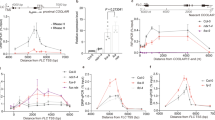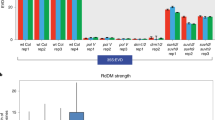Abstract
RNA interference (RNAi) acts on long double-stranded RNAs (dsRNAs) in a variety of eukaryotes to generate small interfering RNAs that target homologous messenger RNA, resulting in their destruction. This process is widely used to ‘knock-down’ the expression of genes of interest to explore phenotypes1,2,3. In plants3,4,5, fission yeast6,7,8, ciliates9,10, flies11 and mammalian cells12,13, short interfering RNAs (siRNAs) also induce DNA or chromatin modifications at the homologous genomic locus, which can result in transcriptional silencing or sequence elimination14. siRNAs may direct DNA or chromatin modification by siRNA–DNA interactions at the homologous locus4,5. Alternatively, they may act by interactions between siRNA and nascent transcript15,16. Here we show that in fission yeast (Schizosaccharomyces pombe), chromatin modifications are only directed by RNAi if the homologous DNA sequences are transcribed. Furthermore, transcription by exogenous T7 polymerase is not sufficient. Ago1, a component of the RNAi effector RISC/RITS complex, associates with target transcripts and RNA polymerase II. Truncation of the regulatory carboxy-terminal domain (CTD) of RNA pol II disrupts transcriptional silencing, indicating that, like other RNA processing events17,18,19, RNAi-directed chromatin modification is coupled to transcription.
This is a preview of subscription content, access via your institution
Access options
Subscribe to this journal
Receive 51 print issues and online access
$199.00 per year
only $3.90 per issue
Buy this article
- Purchase on Springer Link
- Instant access to full article PDF
Prices may be subject to local taxes which are calculated during checkout




Similar content being viewed by others
References
Hannon, G. J. & Rossi, J. J. Unlocking the potential of the human genome with RNA interference. Nature 431, 371–378 (2004)
Mello, C. C. & Conte, D. Jr. Revealing the world of RNA interference. Nature 431, 338–342 (2004)
Baulcombe, D. RNA silencing in plants. Nature 431, 356–363 (2004)
Jones, L., Ratcliff, F. & Baulcombe, D. C. RNA-directed transcriptional gene silencing in plants can be inherited independently of the RNA trigger and requires Met1 for maintenance. Curr. Biol. 11, 747–757 (2001)
Mette, M. F., Aufsatz, W., van der Winden, J., Matzke, M. A. & Matzke, A. J. Transcriptional silencing and promoter methylation triggered by double-stranded RNA. EMBO J. 19, 5194–5201 (2000)
Volpe, T. A. et al. Regulation of heterochromatic silencing and histone H3 lysine-9 methylation by RNAi. Science 297, 1833–1837 (2002)
Schramke, V. & Allshire, R. Hairpin RNAs and retrotransposon LTRs effect RNAi and chromatin-based gene silencing. Science 301, 1069–1074 (2003)
Lippman, Z. & Martienssen, R. The role of RNA interference in heterochromatic silencing. Nature 431, 364–370 (2004)
Mochizuki, K., Fine, N. A., Fujisawa, T. & Gorovsky, M. A. Analysis of a piwi-related gene implicates small RNAs in genome rearrangement in Tetrahymena. Cell 110, 689–699 (2002)
Mochizuki, K. & Gorovsky, M. A. Small RNAs in genome rearrangement in Tetrahymena. Curr. Opin. Genet. Dev. 14, 181–187 (2004)
Pal-Bhadra, M. et al. Heterochromatic silencing and HP1 localization in Drosophila are dependent on the RNAi machinery. Science 303, 669–672 (2004)
Kawasaki, H. & Taira, K. Induction of DNA methylation and gene silencing by short interfering RNAs in human cells. Nature 431, 211–217 (2004)
Morris, K. V., Chan, S. W., Jacobsen, S. E. & Looney, D. J. Small interfering RNA-induced transcriptional gene silencing in human cells. Science 305, 1289–1292 (2004)
Matzke, M. A. & Birchler, J. A. RNAi-mediated pathways in the nucleus. Nature Rev. Genet. 6, 24–35 (2005)
Martienssen, R. A. Maintenance of heterochromatin by RNA interference of tandem repeats. Nature Genet. 35, 213–214 (2003)
Grewal, S. I. & Moazed, D. Heterochromatin and epigenetic control of gene expression. Science 301, 798–802 (2003)
Orphanides, G. & Reinberg, D. A unified theory of gene expression. Cell 108, 439–451 (2002)
Proudfoot, N. New perspectives on connecting messenger RNA 3′ end formation to transcription. Curr. Opin. Cell Biol. 16, 272–278 (2004)
Reed, R. Coupling transcription, splicing and mRNA export. Curr. Opin. Cell Biol. 15, 326–331 (2003)
Noma, K. et al. RITS acts in cis to promote RNA interference-mediated transcriptional and post-transcriptional silencing. Nature Genet. 36, 1174–1180 (2004)
Verdel, A. et al. RNAi-mediated targeting of heterochromatin by the RITS complex. Science 303, 672–676 (2004)
Partridge, J. F., Borgstrom, B. & Allshire, R. C. Distinct protein interaction domains and protein spreading in a complex centromere. Genes Dev. 14, 783–791 (2000)
Partridge, J. F., Scott, K. S., Bannister, A. J., Kouzarides, T. & Allshire, R. C. cis-acting DNA from fission yeast centromeres mediates histone H3 methylation and recruitment of silencing factors and cohesin to an ectopic site. Curr. Biol. 12, 1652–1660 (2002)
Motamedi, M. R. et al. Two RNAi complexes, RITS and RDRC, physically interact and localize to noncoding centromeric RNAs. Cell 119, 789–802 (2004)
Sugiyama, T., Cam, H., Verdel, A., Moazed, D. & Grewal, S. I. RNA-dependent RNA polymerase is an essential component of a self-enforcing loop coupling heterochromatin assembly to siRNA production. Proc. Natl Acad. Sci. USA 102, 152–157 (2005)
Aranda, A. & Proudfoot, N. Transcriptional termination factors for RNA polymerase II in yeast. Mol. Cell 7, 1003–1011 (2001)
Scafe, C., Nonet, M. & Young, R. A. RNA polymerase II mutants defective in transcription of a subset of genes. Mol. Cell. Biol. 10, 1010–1016 (1990)
Herr, A. J., Jensen, M. B., Dalmay, T. & Baulcombe, D. C. RNA polymerase IV directs silencing of endogenous DNA. Science 308, 118–120 (2005)
Onodera, Y. et al. Plant nuclear RNA polymerase IV mediates siRNA and DNA methylation-dependent heterochromatin formation. Cell 120, 613–622 (2005)
Pidoux, A. L., Richardson, W. & Allshire, R. C. Sim4: a novel fission yeast kinetochore protein required for centromeric silencing and chromosome segregation. J. Cell Biol. 161, 295–307 (2003)
Acknowledgements
We thank members of the Allshire laboratory for advice, discussion and comments on the manuscript; E. Bayne for the model; P. Dunoyer and O. Voinnet for help with siRNA detection; T. Jenuwein for anti-H3K9me2 serum; and other members of the EC FP6 ‘The Epigenome’ Network for input. This research was supported by funding from the Wellcome Trust to R.C.A., who is a Wellcome Trust Principal Research Fellow.
Author information
Authors and Affiliations
Corresponding author
Ethics declarations
Competing interests
Reprints and permissions information is available at npg.nature.com/reprintsandpermissions. The authors declare no competing financial interests.
Supplementary information
Supplementary Notes
This contains Supplementary Figures S1-S3 and Supplementary Tables 1-3 (DOC 299 kb)
Rights and permissions
About this article
Cite this article
Schramke, V., Sheedy, D., Denli, A. et al. RNA-interference-directed chromatin modification coupled to RNA polymerase II transcription. Nature 435, 1275–1279 (2005). https://doi.org/10.1038/nature03652
Received:
Accepted:
Published:
Issue Date:
DOI: https://doi.org/10.1038/nature03652
This article is cited by
-
Connecting the dots of RNA-directed DNA methylation in Arabidopsis thaliana
Chromosome Research (2014)
-
Mediator regulates non-coding RNA transcription at fission yeast centromeres
Epigenetics & Chromatin (2012)
-
Cell cycle control of centromeric repeat transcription and heterochromatin assembly
Nature (2008)
-
Delayed resistance to Cucumber mosaic virus mediated by 3’UTR-derived hairpin RNA
Science Bulletin (2008)
-
Physical and functional coupling of RNA-dependent RNA polymerase and Dicer in the biogenesis of endogenous siRNAs
Nature Structural & Molecular Biology (2007)
Comments
By submitting a comment you agree to abide by our Terms and Community Guidelines. If you find something abusive or that does not comply with our terms or guidelines please flag it as inappropriate.



